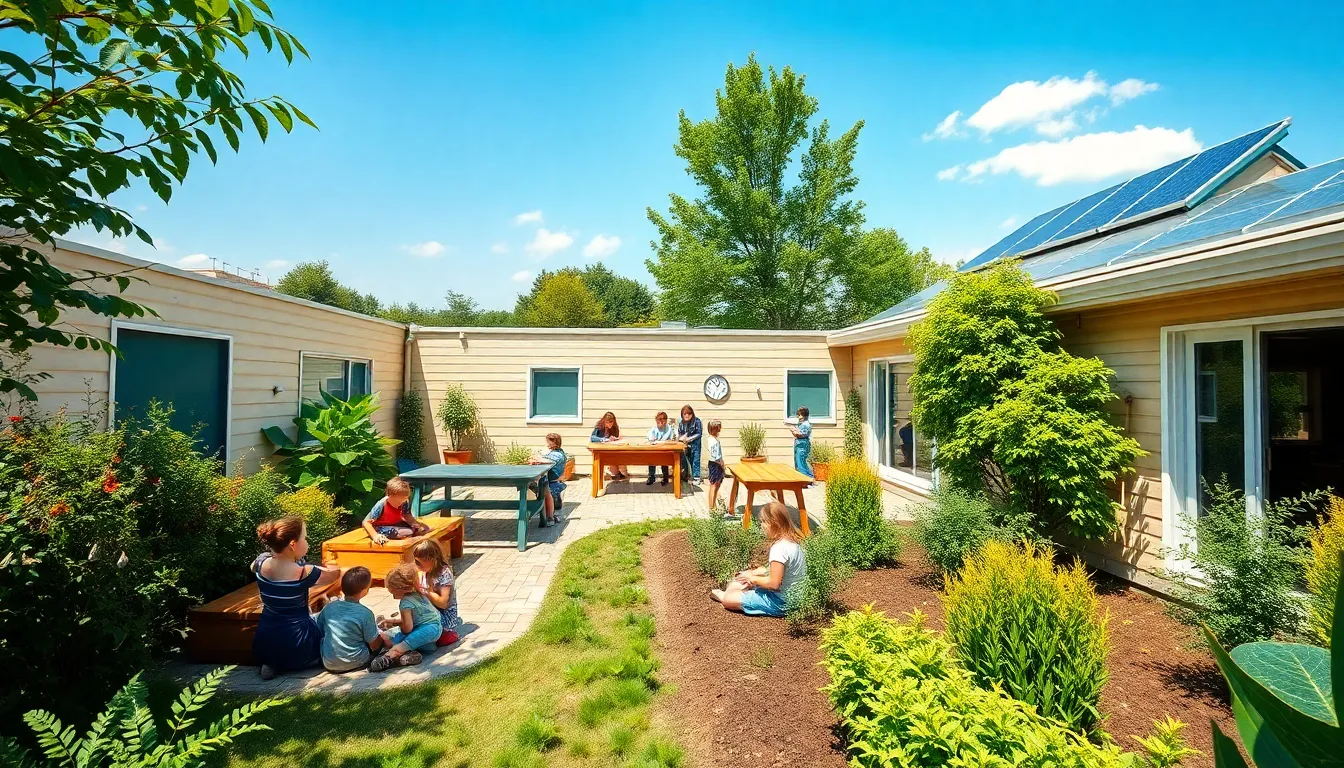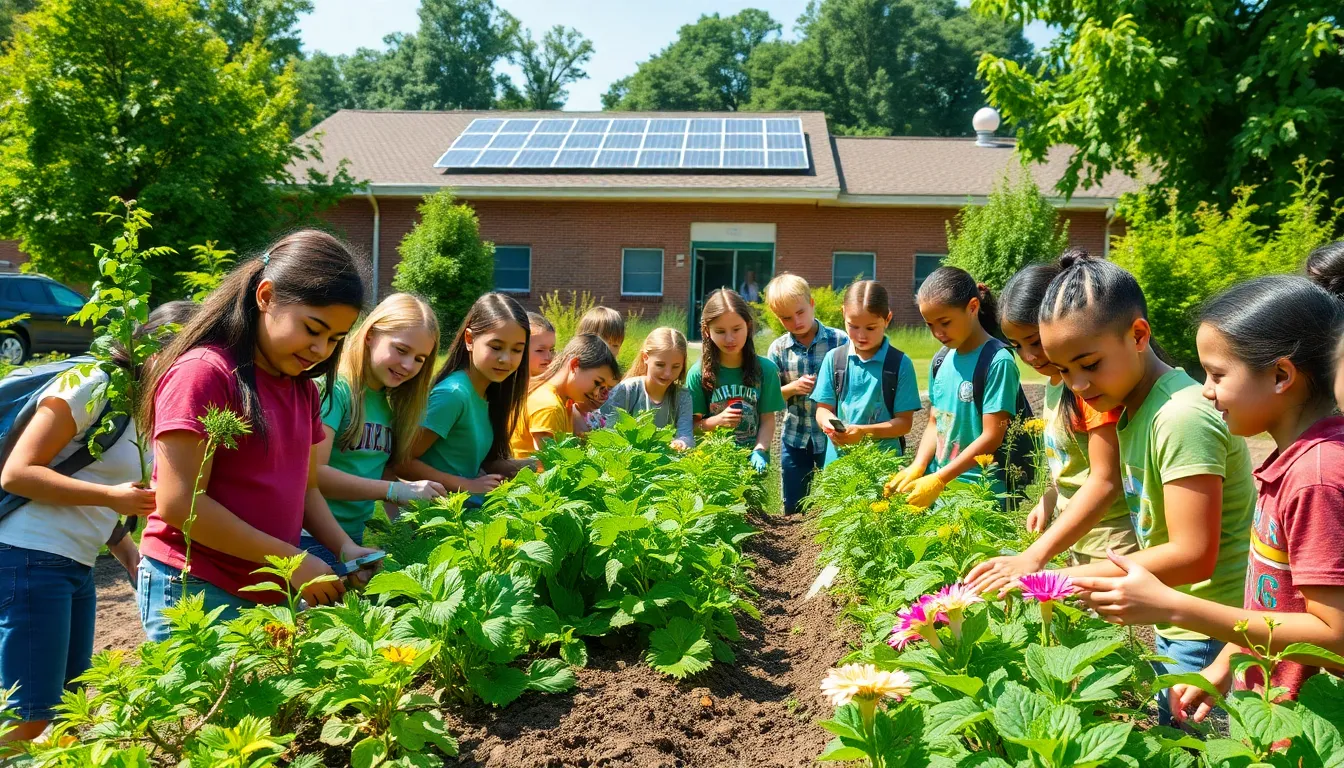As environmental concerns grow, the concept of green schools is gaining momentum across the globe. These educational institutions prioritize sustainability and eco-friendliness, creating healthier learning environments for students. By integrating green practices, schools not only reduce their carbon footprint but also inspire the next generation to be mindful of their impact on the planet.
Green schools focus on energy efficiency, waste reduction, and the use of sustainable materials. This innovative approach fosters a culture of environmental stewardship among students and staff alike. As communities recognize the importance of preparing children for a sustainable future, green schools are becoming essential in shaping a more conscious society.
Table of Contents
ToggleOverview of Green Schools
Green schools embody an educational approach that prioritizes environmental responsibility through sustainable practices. These institutions aim to provide healthier learning spaces while cultivating awareness and action towards sustainability among students.
Definition of Green Schools
Green schools emphasize eco-friendliness, sustainability, and energy efficiency in their operations and curriculum. They incorporate responsible environmental practices, such as using renewable energy sources, sustainable materials, and waste reduction strategies. These schools often focus on integrating environmental education into their programs, fostering a deep understanding of ecological issues in students.
Importance of Sustainable Education
Sustainable education plays a critical role in shaping future generations. It equips students with knowledge about environmental challenges and teaches them the skills necessary to address these issues. Students learn the significance of conservation, resource management, and social responsibility. Schools that prioritize sustainable education cultivate environmentally conscious citizens prepared to contribute positively to society and the planet.
Benefits of Green Schools

Green schools provide numerous advantages that enhance both the environment and the well-being of students. These benefits encompass environmental improvements, health protections, and economic gains.
Environmental Benefits
Green schools significantly reduce their ecological footprint. These institutions implement energy-efficient systems, such as solar panels and LED lighting, decreasing reliance on non-renewable energy sources. They promote waste reduction through recycling programs and composting initiatives. Vegetative roofs, green spaces, and rain gardens improve air quality and support biodiversity by providing habitats for local wildlife. By cultivating sustainable practices, green schools play a crucial role in combating climate change.
Health and Well-being Benefits
Green schools enhance students’ health and well-being. Better indoor air quality results from using non-toxic materials and improved ventilation systems, leading to fewer respiratory problems and allergens. Natural lighting in classrooms elevates mood and increases focus, fostering a conducive learning environment. Access to green spaces encourages physical activity, reducing stress and promoting mental clarity. Additionally, integrating environmental education instills a sense of responsibility and connection to the planet, empowering students to make healthier lifestyle choices.
Economic Advantages
Green schools offer significant economic benefits. Initial investments in sustainable infrastructure often lead to long-term savings through lower energy and maintenance costs. Studies indicate that green school buildings can save up to 30% in energy costs. Increased student attendance rates and enhanced academic performance result in better funding opportunities and community support. Green schools also attract families seeking environmentally conscious education options, boosting local economies and property values. By investing in sustainable practices, these schools provide a solid foundation for financial stability and growth.
Key Features of Green Schools
Green schools incorporate essential features that promote sustainability and environmental consciousness. These features enhance student health, reduce ecological footprints, and provide innovative learning spaces.
Sustainable Architecture
Sustainable architecture forms the backbone of green schools. Energy-efficient designs utilize materials that minimize environmental impact. Renewable energy sources, such as solar panels and wind turbines, power facilities, reducing reliance on fossil fuels. Natural ventilation systems maximize fresh air and regulate temperature, leading to a lower carbon footprint. Green roofs, which incorporate vegetation, also improve insulation and biodiversity.
Eco-friendly Practices
Eco-friendly practices are integral to the operations of green schools. Waste reduction initiatives, such as comprehensive recycling and composting programs, significantly cut down landfill contributions. Water conservation measures, including rainwater harvesting and low-flow fixtures, reduce water usage and foster responsible consumption habits. Organic landscaping features native plants that require minimal maintenance, further enhancing local ecosystems.
Curriculum Integration
Curriculum integration of sustainability-focused education enhances student learning. Environmental science courses provide knowledge about ecological issues and empower students to engage in local conservation efforts. Hands-on projects, such as school gardens, offer practical experiences in sustainable practices. Extracurricular programs, like eco-clubs and community service initiatives, instill environmental stewardship and encourage civic engagement among students.
Challenges Faced by Green Schools
Green schools encounter several challenges that can hinder their full potential in promoting sustainability. Key areas of concern include funding, community involvement, and policy barriers.
Funding and Resources
Funding for green schools often proves inadequate. Many rely on grants or donations to implement sustainable practices. Limited budgets can restrict the procurement of eco-friendly materials, renewable energy systems, or efficiency upgrades. Furthermore, the initial investment in green technology may deter schools from pursuing long-term savings. Financial constraints affect the ability to provide adequate professional development for staff, which is crucial for teaching sustainability concepts effectively.
Community Involvement
Community involvement is essential for the success of green schools, yet it can be challenging to achieve. Engaging parents, local businesses, and community organizations often requires significant effort and strategic outreach. Misconceptions about the benefits of green practices may lead to reluctance among community members. Additionally, varying levels of commitment to environmental initiatives can result in inconsistent support and participation. Schools must effectively communicate the long-term benefits to foster active community collaboration.
Policy and Regulation Barriers
Policy and regulatory frameworks can pose significant barriers to the establishment of green schools. Existing laws may not support innovative sustainability initiatives or create obstacles for schools seeking to adopt eco-friendly practices. Navigating these regulations can be complex and time-consuming, discouraging schools from pursuing green certifications or initiatives. Furthermore, insufficient government incentives for implementing sustainable measures may limit the willingness of schools to make necessary changes. Addressing these policy barriers is crucial for facilitating the growth and success of green schools.
Green schools represent a transformative approach to education that prioritizes sustainability and well-being. By fostering an environment where students learn about ecological responsibility, these institutions play a crucial role in shaping future generations. The benefits extend beyond improved health and learning conditions to encompass economic advantages for local communities.
Despite the challenges they face, the commitment to sustainable practices and education continues to grow. As awareness increases and communities rally around green initiatives, the potential for positive change becomes even more significant. Investing in green schools is investing in a healthier planet and a brighter future for all.




